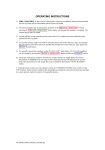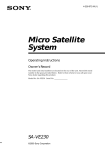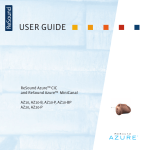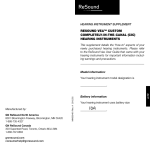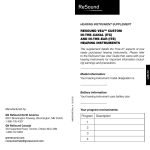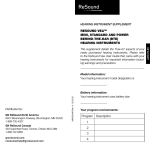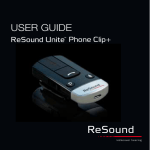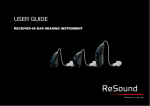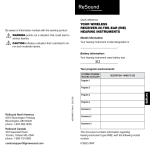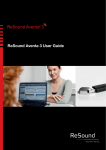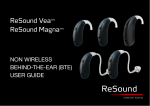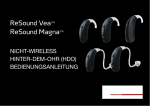Download USER GUIDE - GN ReSound
Transcript
USER GUIDE Custom Models: CIC (COMPLETELY-IN-CANAL) ITC (In-the-canal) ITE (In-the-ear) Introduction Congratulations on the purchase of your new hearing instruments. ReSound’s innovative sound technology and design, combined with the customised set-up selected by your hearing care professional, will make hearing a more enjoyable experience. Hearing instruments will enable you to hear sounds that you may not have heard in years because of your hearing loss. Practice and a positive attitude are important in learning to use hearing instruments. Your ReSound instruments have been adjusted according to your individual hearing loss and needs. Some people adjust quickly to wearing hearing instruments in their ears and hearing new sounds; other people may need more time. Please read this manual carefully in order to wholly benefit from the use of your hearing instruments. With proper care, maintenance, and usage, your hearing instruments will aid you in better communication for many years. Ask your hearing care professional if you have any questions. 2 ReSound is a registred trade mark of GN ReSound A/S Hearing instrument model: Model Battery size Tube type: Left serial number: VE10 10A VE30 312 VE50 13 Dome size: Right serial number: 3 Symbols WARNING points out a situation that could lead to serious injuries, CAUTION indicates a situation that could lead to minor and moderate injuries. Advice and tips on how to handle your hearing instrument better. 4 Contents Operation of the hearing instrument . . . . . 17 Cleaning hearing instruments . . . . . . . . . . 27 Introduction . . . . . . . . . . . . . . . . . . . . . . . . 2 Volume control (optional) . . . . . . . . . . . . . 17 Replacing wax filters . . . . . . . . . . . . . . . . 28 Description of the hearing instruments . . . . 6 Program button (optional) . . . . . . . . . . . . . 18 General precautions . . . . . . . . . . . . . . . . 30 Getting started . . . . . . . . . . . . . . . . . . . . 10 Telephone use . . . . . . . . . . . . . . . . . . . . 20 General warnings . . . . . . . . . . . . . . . . . . 31 On/Off function . . . . . . . . . . . . . . . . . . . . 10 Telecoil (optional) . . . . . . . . . . . . . . . . . . . 22 Battery warning Information . . . . . . . . . . . 33 SmartStart . . . . . . . . . . . . . . . . . . . . . . . 11 PhoneNow . . . . . . . . . . . . . . . . . . . . . . . 22 Troubleshooting guide . . . . . . . . . . . . . . . 34 Inserting/Replacing the battery . . . . . . . . 12 Tele-loop systems . . . . . . . . . . . . . . . . . . 25 Technical data . . . . . . . . . . . . . . . . . . . . . 42 Low battery indicator . . . . . . . . . . . . . . . . 13 Care and maintenance . . . . . . . . . . . . . . 26 Warranty and repairs . . . . . . . . . . . . . . . . 45 Inserting/removing hearing instruments . . 14 Daily maintenance . . . . . . . . . . . . . . . . . . 27 5 Description of the hearing instruments: Completely-in-the-canal (CIC) Resound Vea™ VE110, VE110-P, VE210, VE210-P, VE310, VE310-P 1. Battery compartment and On/Off switch 2. Removal cord (optional) 3. Sound outlet 4. Wax filter 5.Venting 6. Microphone sound inlet(s) 7.Model 8.Manufacturer 9. Serial number 3 3/4 6 6 1 2 8 GN ReSound Resound Vea XXX XXX X 7 5 6 2 9 1 2 7 In-the-canal (ITC) and In-the-ear (ITE) ReSound VeaTM VE130, VE130-P, VE230, VE230-D, VE230-P, VE230-DP, VE330, VE330-D, VE-330-P, VE330-DP VE150, VE150-P, VE250, VE250-D, VE250-P, VE250-DP, VE350, VE350-D, VE350-P, VE350-DP 1. Programme button 2. Battery compartment and On/Off switch 3. Sound outlet 4. Wax filter 5.Venting 6. Microphone sound inlet(s) 7. Volume control (optional) 8.Model 9.Manufacturer 10. Serial number 2 3/4 6 GN R ReS eSoun ou d X X X nd Vea XXX X 8 1 7 8 9 6 5 5 10 9 Getting started On/Off function 1. When the battery door is closed, the hearing instrument turns on, and the default program will be activated. 2. To turn off the hearing instrument, open the battery door. Many individuals can use their fingernail to pull it open. Tip: Whenever the hearing instruments are not in use, remember to open the battery doors to avoid unnecessary battery consumption. 10 On Off SmartStart Hearing instruments can be turned on once you have placed them in your ears. If you prefer to turn them on just prior to placing them in your ears, your hearing care professional can activate a function called SmartStart. This function will delay the time in which the hearing instruments turn on by ten seconds after the battery compartment is closed. This reduces the risk that the hearing instruments will whistle while you put them in. With SmartStart, a beep will be heard for each second of the delay period. 11 Inserting/Replacing the battery 1. Open the battery door completely by using your fingernail. 2. Remove the used battery if present. Insert the new battery with the positive side in the correct position. The battery door has a ‘+’ indicator to help determine the correct insertion. 3. Always use new Zinc-Air batteries that have a minimum remaining shelf-life of 1 year. 4. Gently close the battery door. 12 Tip: When the hearing instruments are not in use for an extended period of time, removing the batteries may help prevent corrosion of the battery compartment, and ensure that battery life is not shortened. Low battery indicator Your hearing care professional can set your hearing instrument to give an acoustical indication when the battery is reaching its end of life. The hearing instrument will reduce amplification and emit a melody if battery power gets too low. This signal will recur every five minutes until the hearing instrument automatically switches off. It is recommended that you keep spare batteries on hand. 13 Inserting/Removing hearing instruments Insertion (CIC, ITC, and ITE) 1. Hold the hearing instrument between your thumb and index finger, either above and below or on the sides. 2. Place the sound outlet portion into your ear canal. Twist the hearing instrument slightly back and forth until it sits well and comfortably inside your ear. Opening and closing your mouth may ease insertion 14 By experimenting, an easier method may be discovered. With proper insertion, hearing instruments should fit snugly but comfortably. If hearing instruments cause irritation of the ears, contact your hearing care professional. Never attempt to modify the shape of the hearing instrument yourself. Tip: It may be helpful to pull your ear up and outward with your opposite hand during insertion. Removal (ITC and ITE) 1. Hold the edges of the hearing instrument with your thumb and forefinger. 2. Pull outward while slightly rotating your hand forward. 15 Removal (CIC) 1. Hold the removal cord with your thumb and index finger and pull outward. 2. Hold the edges of the hearing instrument with your thumb and forefinger and pull outward while slightly rotating your hand forward. Note: Consult your hearing care professional if you have difficulty removing the hearing instruments. 16 Operation of the hearing instrument Volume control (ITC and ITE models) The volume control will allow the volume of hearing instruments to be increased or decreased. 1. To increase the volume, rotate the volume control forward (towards your face when you are wearing the hearing instruments). 2. To decrease the volume, rotate the volume control backward (away from your face). Please note that when you turn the volume all the way down (until the volume control wheel stops rotating), the device will be turned off. To reboot the device, turn the volume back up by rotating the volume control forward. If you prefer not to use the volume control, your hearing care professional can deactivate it. 17 Programme button Depending on your experience level with hearing instruments, individual hearing needs, and the type of listening environments you experience, your hearing care professional may activate additional programmes in the hearing instrument. If additional programmes have been activated, the following list explains how they work. 1. You can switch between programmes by pushing the programme button once. 2. You will then hear one or more beeps. The number of beeps indicates which programme you have selected (one beep=programme one, two beeps=programme two, etc.). 3. When the hearing instruments are turned off and then back on, the hearing instrument always returns to the default setting (programme one). 18 Programme Description of when to use 1 2 3 4 19 Telephone use Finding the optimal position for holding a telephone may require practice for some individuals, and one or more of the following suggestions may be helpful. 4. Any whistling may also be decreased by holding the telephone slightly away from the ear. 5. Depending on your individual needs, your hearing care professional may activate a programme specifically for telephone use. 1. Hold the telephone as you would normally. 2. Hold the telephone towards the top of the ear (closer to where the microphones are). 3. If whistling occurs, holding the telephone in the same position may help the hearing instrument to adapt. 20 21 Telecoil (optional on some ITC and ITE models) If equipped, a telecoil can be activated by your hearing care professional and accessed through one of the additional programmes. A telecoil picks up a telephone’s magnetic signal and converts it to sound. An optional telephone programme may help to improve speech understanding on the telephone. When using a telecoil programme, the receiver of the telephone may need to be held closer to the hearing instrument. The handset of the telephone may need to be moved to slightly different positions in order to find the best reception. PhoneNow The PhoneNow function, available on some hearing instrument models, allows your hearing instrument to automatically switch to you telephone program when a telephone receiver is raised to the ear. When the telephone receiver is removed from the ear, the hearing instrument automatically returns to the previous listening program. 22 Placement of PhoneNow magnets While some telephone receivers produce a magnetic field strong enough to activate the Phone Now function, other telephone receivers require an additional magnet to be placed on the tele phone receiver. In order to place the PhoneNow magnet properly: 1. Clean the telephone receiver thoroughly. 2. Hold the telephone vertically, in a position similar to when making a telephone call. 3. Place the magnet just below the telephone receiver. If necessary, move the magnet to another position to improve ease of use and comfort while speaking. Tip: Use only recommended cleaning agent to clean the telephone prior to placing the magnet on the phone in order to obtain best possible adherence. 23 PhoneNow usage Telephones can be used in a normal manner. A beep signal will indicate that the PhoneNow feature has automatically switched the hearing instrument to your telephone program. Initially, you may need to move the telephone receiver slightly to find the best position for reliable PhoneNow activation and good hearing on the telephone. PhoneNow warnings 1. Keep magnets out of reach of pets, children and mentally challenges persons. If a magnet is swallowed, please seek advice from a medical practitioner. 2. The magnet used to supplement the magnetic field of a telephone receiver may affect some medical devices or electronic systems. The manufacturer of any magnetically sensitive devices (e.g. pacemakers) should advise you regarding appropriate safety precautions when using your hearing instrument and magnet in close proximity to the medical device or electronic system in question. 24 If the manufacturer cannot issue a statement, we recommend keeping the magnet or a telephone equipped with the magnet 30 cm (12”) away from magnetically sensitive devices (e.g. pacemakers). PhoneNow Precautions 1. High distortion during dialing or phoning may mean that the magnet is not in the optimal position relative to the telephone receiver. To avoid the issue, please move the magnet to another place on the telephone receiver. 2. Only use magnets supplied by GN ReSound Tele-loop systems Many places, such as theatres, houses of worship, and schools are equipped with tele-loop systems. When using a telecoil programme with tele-loop systems, sound is picked up directly and may improve speech understanding. If there is no sound from the hearing instruments in 25 a tele-loop system and with a telecoil programme activated, the tele-loop system may not be turned on or is not operating correctly. If a facility is not equipped with a tele-loop system, sitting as close as possible to the front may be helpful. Care and maintenance Your hearing instrument is protected by a layer of protective, hydrophobic nanocoat material. Please follow the following instructions to prolong the durability of your hearing instruments: 1. Keep your hearing instrument clean and dry. Wipe the case with a soft cloth or tissue after use to remove grease or moisture. Do not use water or solvents, as these can damage the hearing instrument(s). 2. Never immerse hearing instruments in water or other liquids, as liquids may cause permanent damage to the hearing instruments. 3. Avoid rough handling of hearing instruments or dropping them on hard surfaces or floors. 4. Do not leave hearing instruments in or near direct heat or sunlight, such as in a hot, parked car, as excessive heat can cause damage or deform the casing. 26 5. Do not wear your instrument while showering, swimming, in heavy rain or in a moist atmosphere such as a steam bath or sauna. 6. If your instrument does get wet, or if it has been exposed to high humidity or perspiration, it should be left to dry out overnight with the battery out and the battery compartment open. It is also a good idea to put the instrument and battery in a sealed container together with a drying agent (desiccator) overnight. Do not use the instrument until it is completely dry. Consult your hearing care professional as to which drying agent to use. 7. Remove your hearing instrument when applying such things as cosmetics, perfume, aftershave, hair spray, and suntan lotion. These might get into the instrument and cause damage. Daily maintenance It is important to keep your hearing instrument clean and dry. On a daily basis, clean the hearing instruments using a soft cloth or tissue. Remove any wax or debris from hearing instruments using a brush and/or a wire loop. In order to avoid damage due to humidity or excessive perspiration, the use of a drying kit is recommended. Some drying kits are electric, and in addition to thoroughly drying out hearing instruments, they may help sanitize. 27 Replacing wax filters Custom hearing instruments may have wax filters that protect against wax and moisture. It is recommended that these are changed as needed. To change these filters, the following steps are needed: 1. Brush the sound outlet area with the sound outlet pointed down. 2. Insert the threaded end of the wax filter tool into the used wax filter, and gently rotate clockwise. 3. Gently pull until the used filter is removed. 4. Discard the used filter in the slot located in the wax filter kit by pressing it into the center, sliding it to one end of the slot, and pull until the filter is discarded. 5. Flip the wax filter tool around, locate a new filter in the dial, and press the tip of the tool into the center of the dial. 6. Gently pull the new filter out of the dial. 7. Align the new filter to the sound outlet. 28 8. Press the new filter into the opening, and simultaneously pull and rock back and forth until the new wax filter is in place. Tip: Pressing on the new filter with the flat side of the wax filter tool can give extra insurancethat the filter is correctly in place. Note: If a different type of wax filter is used for your hearing instruments, or if your hearing instruments do not utilise wax filters, consult your hearing care professional for proper instruction. Temperature test, transport and storage information GN ReSound Hearing Instruments are subjected to various tests in temperature and damp heating cycling between -25C (-13F) and +70C (+158F) according to internal and industry standards. During transport or storage, the temperature should not exceed the limit values of -20C (-4F) to +60C (+140F) and relative humidity of 90% RH, non-condensing (for limited time). The air pressure between 500 and 1100 hPa is appropriate. 29 General precautions 1. Do not leave hearing instruments in the sun, near an open fire, or in a hot, parked car. 2. Do not wear hearing instruments while showering, swimming, in heavy rain, or in a moist atmosphere such as a steam bath or sauna. 3. Should the hearing instrument become moist, remove the battery and place the hearing instrument in a closed container with a drying agent. Your hearing care professional can provide options for drying containers or kits. 4. Remove the hearing instruments when applying items such as cosmetics, perfume, after shave, hair spray, and suntan lotion. 5. Use only original ReSound consumables e.g. tubes and domes. 6. Only connect ReSound hearing instruments to ReSound accessories intended and qualified to be used with ReSound hearing instruments. 7. Never attempt to modify the shape of the hearing instrument, ear-moulds, or tubing yourself. 30 General warnings 1. Consult a hearing care professional if you discover a foreign object in your ear canal, if you experience skin irritation, or if excessive ear wax accumulates with the use of the hearing instrument. 2. Different types of radiation, from e.g. NMR, MRI, or CT scanners, may damage hearing instruments. It is recommended not to wear hearing instruments during these or other similar procedures. Other types of radiation, such as burglar alarms, room surveillance systems, radio equipment, mobile telephones, contain less energy and will not damage hearing instruments. However, they have the potential to momentarily affect the sound quality or temporarily create strange sounds from hearing instruments. 3. Do not wear hearing instruments in mines, oil fields, or other explosive areas unless those areas are certified for hearing instrument use. 31 4. Do not allow others to use your hearing instruments. This may cause damage to the hearing instruments or to the hearing of the other individual. 5. Instrument usage by children or mentally challenged persons should be supervised at all times to ensure their safety. The hearing instrument contains small parts that could be swallowed by children. Please be mindful not to leave children unsupervised with this hearing instrument. 6. Hearing instruments should be used only as prescribed by your hearing care professional. Incorrect use may result in hearing loss. 7. External devices connected to the electrical input must be safe according to the requirements of IEC 60601-1-1, IEC 60065, or IEC 60950-1, as appropriate 8. If device is broken, do not use. 32 Battery warning information Batteries, although very small, contain dangerous substances, and should be disposed of carefully. This is for the safety of you and the environment. Please note: 1. DO NOT attempt to recharge standard zinc air batteries. They may leak or explode. 2. DO NOT attempt to dispose of batteries by burning them. Used batteries are harmful to the environment. Please dispose of them according to local regulations or return them to your hearing care practitioner. 3. DO NOT place batteries in your mouth. Consult a physician immediately if a battery has been swallowed, as they can be harmful to your health. 4. Keep batteries away from pets, children and mentallly challenged persons. 5. Remove the batteries to prevent leakage when the hearing instruments are not in use for an extended period of time. 33 Troubleshooting Guide SYMPTOM No sound 34 CAUSE POSSIBLE REMEDY • Not turned on • Turn on by closing the battery door • Dead battery • Replace battery • Battery door will not close • Insert battery properly • Blocked wax filter • Replace wax filter or consult your hearing care professional 35 Troubleshooting Guide SYMPTOM CAUSE POSSIBLE REMEDY Not loud • Incorrect hearing instrument placement • Reinsert hearing instrument carefully enough • Blocked sound outlet filter • Change filter or consult your hearing care professional • Change in hearing sensitivity • Consult your hearing care professional • Excessive ear wax • Consult your physician • Volume set too low • Increase the volume control if available or consult your hearing care professional 36 37 Troubleshooting Guide SYMPTOM CAUSE POSSIBLE REMEDY Excessive • Incorrect hearing instrument placement • Re-insert hearing instrument carefully whistling / feedback • Excessive ear wax • Consult your physician • Feedback control may need to be adjusted • Consult your hearing care professional • Hearing instrument settings not optimal • Consult your hearing care professional 38 39 Troubleshooting Guide SYMPTOM CAUSE POSSIBLE REMEDY Sound distorted / • Weak battery • Replace battery not clear • Improper hearing instrument fit • Consult your hearing care professional • Hearing instrument damaged • Consult your hearing care professional • Hearing instrument settings not optimal • Consult your hearing care professional If there are any other problems not mentioned in this guide, please contact your hearing care professional. 40 41 Technical Data ITCs Hearing Instrument Model Technical Data ITEs Maximum output (2ccCoupler / IEC 60118-7) Hearing Instrument Model Maximum output (2ccCoupler / IEC 60118-7) VE130, VE230, VE230-D, VE330, VE-330-D 114 dB SP VE150, VE250, VE250-D, VE350, VE350-D 117 dB SPL VE130-P, VE230-P, VE230-DP, VE330-P, VE330-DP 117 dB SPL VE150-P, VE250-P, VE250-DP, VE350-P, VE350-DP 129 dB SPL 42 43 Technical Data CIC Hearing Instrument Model Maximum output (2ccCoupler / IEC 60118-7) VE110, VE210, VE310 112 dB SPL VE110-P, VE210-P, VE310-P 116 dB SPL Warranty and repairs ReSound provides a warranty on hearing instruments in the event of defects in workmanship or materials, as described in applicable warranty documentation. In its service policy, ReSound pledges to secure functionality at least equivalent to the original hearing instrument. As a signatory to the United Nations Global Compact initiative, ReSound is committed to doing this in line with environment-friendly best practices. Hearing instruments therefore, at ReSound discretion, may be replaced by new products or products manufactured from new or serviceable used parts, or repaired using new or refurbished replacement parts. The warranty period of hearing instruments is designated on your warranty card, which is provided by your hearing care professional. For hearing instruments that require service, please contact your hearing care professional for assistance. ReSound hearing instruments that malfunction must be repaired by a ReSound qualified technician. Do not attempt to open the case of hearing instruments, as this will invalidate the warranty. 44 45 Faceplate/Electronics by: GN ReSound A/S Any issues relating to the EU Medical Device Directive 93/42/EEC should be directed to GN ReSound A/S. 46 47 United Kingdom GN ReSound Ltd. Kirtlington Business Centre Portway Kirtlington Oxon OX5 3JA Tel.: +44 1869 352 800 Fax: +44 1869 343 466 www.gnresound.co.uk Australia GN ReSound Pty. Ltd. Unit R1 Regents Park Estate 391 Park Road Regents Park NSW 2143 Tel.: (free) 1800 658 955 Fax: +61 2 9743 7472 www.gnresound.com.au New Zealand GN ReSound (NZ) Ltd. Ground Floor, North Entrance 4 Fred Thomas Drive Takapuna Auckland, 0622 Tel.: (free) 0800 900 126 Fax: (free) 0800 007 695 www.gnresound.co.nz 400038000-GB-12.01-Rev.B Worldwide Headquarters GN ReSound A/S Lautrupbjerg 7 DK-2750 Ballerup, Denmark Tel.: +45 45 75 11 11 Fax: +45 45 75 11 19 www.resound.com

























